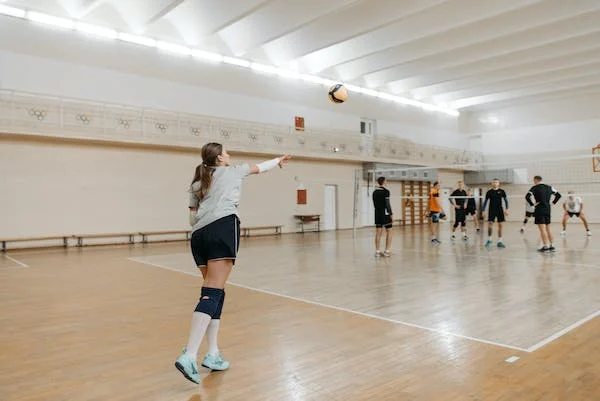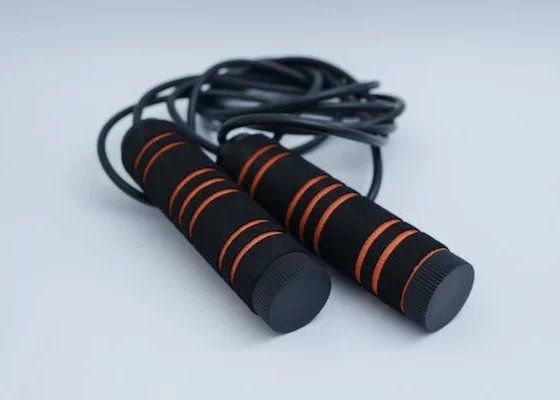Volleyball is an energetic and thrilling sport demanding a distinctive fusion of skill and strategy. Whether you’re a novice player looking to up your game or an experienced athlete seeking to reach new heights, achieving excellence in volleyball entails more than perfecting your technique. It’s about building a robust foundation of physical fitness to complement your skills. This article explores a range of targeted volleyball exercises and training regimens crafted to improve your performance, from serving aces to executing precise spikes.
Understanding Volleyball’s Physical Demands:
Volleyball is a sport that places specific physical demands on its players. To excel, you must develop strength, power, and agility. Let’s delve into what makes this sport unique and understand how these physical attributes are essential to succeeding on the volleyball court.
Exploring the Physical Requirements
Volleyball is a fast-paced game that demands a unique set of physical attributes. Players need to exhibit explosive strength, exceptional hand-eye coordination, and the ability to make quick, precise movements.
The Importance of Strength and Power
Strength and power are the backbone of successful volleyball play. These physical attributes are critical, whether delivering a potent serve or executing a devastating spike.
Agility: The Key to Quick Moves
Agility is the secret weapon of volleyball players. Being able to move swiftly, change direction, and react to fast-paced plays sets the best players apart.
Agility is the capacity to swiftly and efficiently alter the body’s direction and position while maintaining control. This trait demands rapid reflexes, coordination, balance, speed, and adept responses to evolving situations. Being agile entails positioning oneself optimally to execute the following action, whether catching a ball or running a tackle. Agility guarantees that your body and sports equipment are primed to execute subsequent actions effectively.
Serving Up Power: Volleyball Exercises for a Killer Serve
The volleyball serve ranks among the six fundamental volleyball techniques, initiating the volley by putting the ball into play. Uniquely, the serve is solely controlled by one player, a facet advanced players capitalize on by refining their serving prowess.
The intensity of a player’s serve significantly influences the opposing team’s response, determining whether they attack the ball or opt for a more straightforward return like a free ball. Consequently, a player’s serve profoundly impacts the volley’s outcome and, subsequently, the game’s result.
The serve is your team’s first opportunity to gain an advantage and your chance to set the tone for the game. Here are the exercises that will help you achieve that killer serve:
Targeting Shoulder Strength
Your shoulder muscles are crucial for delivering a powerful serve. Exercises that strengthen the rotator cuff and shoulder muscles can significantly enhance your serving ability.
Enhancing Serving Velocity
Serving velocity can differentiate between an easily returnable ball and an ace. We’ll look at exercises that boost your arm speed and power for a lightning-fast serve.
The Role of Core Stability
Core stability is not just about aesthetics; it’s essential for maintaining balance and power in your body. Discover exercises that will help you stabilize your core for more precise serves.
Perfecting Service Accuracy
Accuracy is as important as power when it comes to serving. We’ll explore drills and techniques to ensure your serves consistently hit the mark.

Spiking Techniques and Training Exercises:
A successful spike is a combination of proper technique and explosive power. These exercises will elevate your spiking game, whether aiming for a cross-court kill or a strategically placed tip.
A volleyball spike, also known as an attack, is a strategic maneuver aimed at sending the ball over the net to the opponent in a manner that renders it unreturnable. Executing a spike involves angling the ball to land on the opponent’s court by moving the arm with precision and force, typically at a downward angle.
While powerful spikes are common, skilled players employ various volleyball strategies to outwit their opponents during attacks. One such tactic is the tip or dink, where the ball is contacted in a controlled manner with the fingers and swiftly directed toward the opponent’s court using an open-hand playing action. This deceptive move often catches opponents off guard, primarily if the spiker is known for delivering forceful hits.
Mastering Jump Height
Jumping higher means reaching over blockers and hitting the ball at its peak. Discover exercises and techniques to improve your jump height for devastating spikes.
Improving Arm Swing Velocity
Your arm speed is a critical factor in spiking effectiveness. We’ll explore exercises to help you swing your arm faster, making your spikes more challenging to defend against.
Strengthening Lower Body for Explosive Spikes
Strong legs are essential for generating power in your spikes. Learn how to develop explosive lower-body strength through specific exercises.
Precision in Spiking
Accuracy is as important as power when it comes to spiking. We’ll delve into drills and techniques to ensure your spikes consistently find their target on the opponent’s court.

Agility and Quick Movements: The Key to Court Domination:
More than just speed alone, agility encompasses the notion of skill, where an athlete’s capacity to swiftly and effectively change direction is critical. Whether a basketball player evading a defender or a soccer player maneuvering around opponents to score, agility is a cornerstone of athletic ability. Understanding and honing agility skills are integral to sports training at every stage of development.
Agility and quickness, though related, hold distinct meanings. Quickness refers to the ability to execute a movement in minimal time, reflecting an individual’s reaction speed, and is crucial in sports where split-second decisions determine outcomes. In contrast, agility involves swiftly and effectively changing body direction or position, incorporating quickness, balance, and coordination. While quickness contributes to agility, the latter encompasses various physical abilities. Recognizing this difference is essential for comprehending and designing effective athletic training regimens.
Agility is a pivotal factor in achieving success across numerous sports, enabling athletes to perform intricate movements swiftly and accurately, thus gaining a competitive advantage. Whether outsmarting an opponent on the basketball court or swiftly adjusting to returning a tennis serve, agility empowers athletes to respond and adapt promptly to unforeseen circumstances.
Enhanced agility cultivates improved body control and coordination, mitigating the risk of injuries. It enhances an individual’s capacity to sustain balance amid rapid directional shifts, ultimately bolstering overall physical stability. Consequently, agility is indispensable for improving performance and safeguarding athletes’ well-being in sports.
Volleyball is not just about serving and spiking; it’s also about moving quickly and efficiently on the court. Here are the exercises and strategies to improve your agility and reactions:
Enhancing Footwork and Speed
Footwork and speed are fundamental aspects of agility. We’ll discuss drills to improve your court coverage and move swiftly to respond to plays.
Reaction Time: A Game-Changer
Reacting quickly to your opponent’s moves can give you a significant advantage. We’ll explore exercises to sharpen your reaction time and decision-making on the court.
Incorporating Plyometric Exercises
Plyometric exercises are fantastic for enhancing explosive power and agility. Discover how plyometrics can take your game to the next level.
Defensive Agility Tactics
Defensive agility is a vital part of the game. Learn strategies and exercises to become a formidable defender on the court, whether digging up spikes or making crucial saves.
Holistic Training Approaches for Volleyball:
To become an elite volleyball player, you must consider physical attributes, endurance, mental preparation, recovery, and injury prevention.
Importance of Endurance and Stamina
Endurance and stamina are essential for maintaining your performance throughout a game or a long match. We’ll discuss how to build and maintain these critical attributes.
While the volleyball court confines your range of movement, possessing good endurance is essential to contribute effectively to your team. Volleyball demands numerous rapid, agile movements and frequent jumps, particularly when positioned near the net. Therefore, integrating cardiovascular training into your exercise routine is vital for enhancing your volleyball endurance and preventing fatigue during demanding matches.
Mental Preparation and Focus
In volleyball, the mental aspect is just as crucial as the physical one. We’ll explore mental preparation techniques and staying focused on the court.
Recovery and Injury Prevention
Injuries pose a substantial setback for athletes, regardless of their skill level or experience. Discover methods to prevent injuries and accelerate recovery, enabling you to remain active in the game.
When athletes encounter minor injuries, they must possess the mental fortitude to navigate internal and external challenges. Mental strength entails effective stress management, embracing learning opportunities from mistakes, and enhancing communication skills, which are crucial for maintaining a winning mindset.
Like strength training for muscles, mental training strengthens our minds over time. For volleyball players, this might involve practicing breathing exercises, rebounding from defeats and errors swiftly, or minimizing distractions. No matter an individual’s vulnerabilities, mental resilience is an ability that can be cultivated and enhanced through consistent practice.
Integrating Functional Training
Functional training prepares your body for volleyball’s specific movements and demands. We’ll discuss how to incorporate practical training into your routine.
Conclusion:
Elevating your volleyball game is a multifaceted endeavor encompassing skill refinement and physical conditioning. By dedicating time to targeted exercises for serving, spiking, and agility and embracing a holistic training approach, you’re not just improving your game; you’re shaping yourself into an elite player on the court. Keep practicing, serving, spiking, and sweating—your volleyball journey will reach new heights!



